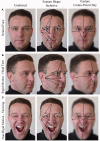A Review and Clarification of the Terms "holistic," "configural," and "relational" in the Face Perception Literature
- PMID: 23413184
- PMCID: PMC3571734
- DOI: 10.3389/fpsyg.2012.00559
A Review and Clarification of the Terms "holistic," "configural," and "relational" in the Face Perception Literature
Abstract
It is widely agreed that the human face is processed differently from other objects. However there is a lack of consensus on what is meant by a wide array of terms used to describe this "special" face processing (e.g., holistic and configural) and the perceptually relevant information within a face (e.g., relational properties and configuration). This paper will review existing models of holistic/configural processing, discuss how they differ from one another conceptually, and review the wide variety of measures used to tap into these concepts. In general we favor a model where holistic processing of a face includes some or all of the interrelations between features and has separate coding for features. However, some aspects of the model remain unclear. We propose the use of moving faces as a way of clarifying what types of information are included in the holistic representation of a face.
Keywords: composite task; configural; holistic; inversion; moving faces; part-whole task; relational.
Figures




References
-
- Bartlett J., Searcy J. H., Abdi H. (2003). “What are the routes to face recognition?” in Perception of Faces, Objects, and Scenes: Analytic and Holistic Processes, eds Peterson M., Rhodes G. (Oxford: Oxford University Press; ), 21–52
LinkOut - more resources
Full Text Sources
Miscellaneous

